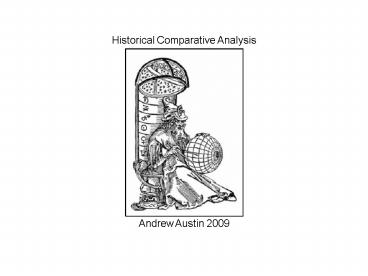Historical Comparative Analysis - PowerPoint PPT Presentation
1 / 7
Title:
Historical Comparative Analysis
Description:
... Building and Citizenship and Kings or People, compares political modernization ... Skocpol theorizes that three countries (Bourbon France, Imperial China, and ... – PowerPoint PPT presentation
Number of Views:276
Avg rating:3.0/5.0
Title: Historical Comparative Analysis
1
Historical Comparative Analysis
Andrew Austin 2009
2
- Juxtaposing historical patterns from two or more
times or places. - Different regions, countries, political systems,
etc. - Different historical periods in the same region,
countries, political system, etc. - Looking at historical trajectories to study
historical change and societal dynamics. - Topics economic development, patterns of
collective violence, political development,
religious evolution, revolutions, rise and fall
of empires, etc.
3
Parallel Demonstration of Theory
Juxtaposing relevant historical trajectories
(case histories) to show the fruitfulness of a
theory or hypothesis.
Shmuel N. Eisenstadt, The Political Systems of
Empires. Uses structural-functionalist theory
to explain the emergence, persistence, and
decline of centralized bureaucratic empires. He
studies several civilizations at various points
in history.
Jeffery Paige, Agrarian Revolution. Uses economic
determinism to explain rural class relations and
potential political behavior of cultivating and
noncultivating classes. He compares Peru, Angola,
and Vietnam.
The point of comparison is to assert a similarity
among the cases. The method characteristically
elaborates theoretical models and hypotheses
before turning to historical case illustrations.
4
Contrast of Contexts
Juxtaposing relevant historical trajectories in
maximally different case histories to show how
unique features of each case affect the working
out of general social processes.
Clifford Geertz, in Islam Observed, examines
religious development in Morocco and Indonesia
and the articulation of modernization in each.
Reinhard Bendix, in Nation-Building and
Citizenship and Kings or People, compares
political modernization in several countries to
show the variety of paths each has taken.
These are works with orienting questions and
ideal-type concepts that sensitize the researcher
to particularities. Method is not causal
analysis, but rather constitutes a caution on
undue generalization and suggests hypotheses.
5
Macro-Causal Analysis
Comparing historical trajectories to make causal
inferences about macro-level structures and
processes to test historical generalizations.
Barrington Moore, Jr., Social Origins of
Dictatorship and Democracy Moore identifies three
alternative routs to modernity (1) bourgeois
revolution to liberal democracy (2) revolution
from above to fascism (3) peasant revolution
to communism. Compares sets of countries that
follow similar routes and contrasts these with
sets that follow different paths.
Theda Skocpol, States and Social Revolutions
Skocpol theorizes that three countries (Bourbon
France, Imperial China, and Tsarist Russia)
experience revolutionary crises for similar
analytic reasons. She compares these instances to
countries that did not experience revolutionary
crises. These non-revolutionary instances act as
controls.
6
Method of Agreement/Difference
Method of Agreement Establishes that several
cases having a common phenomenon to be explained
also have in common the hypothesized causal
factor.
Method of Difference Contrast cases in which the
phenomenon to be explained and the hypothesized
cause are both absent, although they are as
similar as possible to the positive causes in
other respects.
7
Hypothesis developed into general theory
Limits set to overly general theory
Parallel
Macro-Causal
Contrast-Oriented
Contrasts suggest testable hypotheses





























